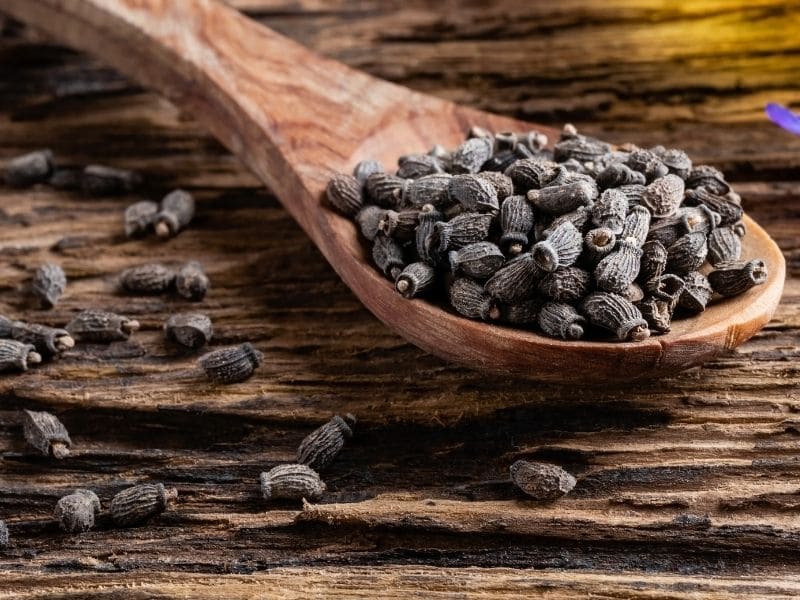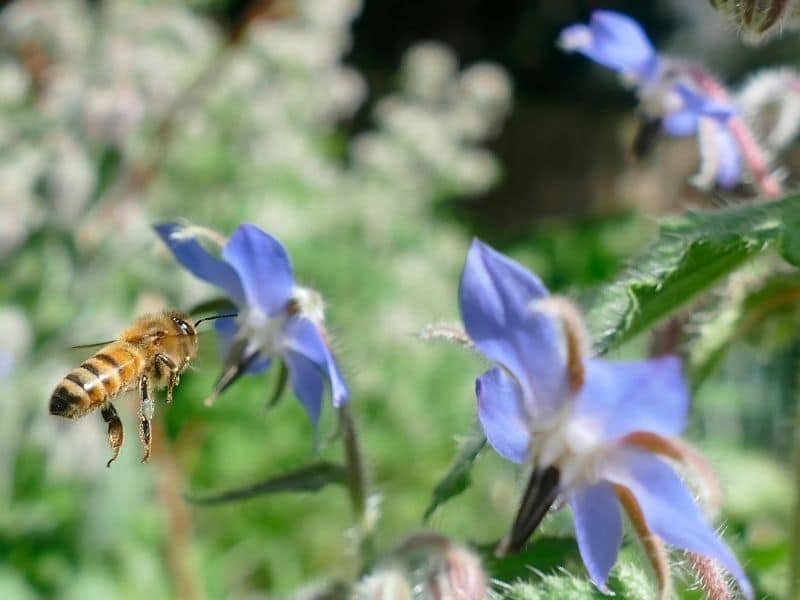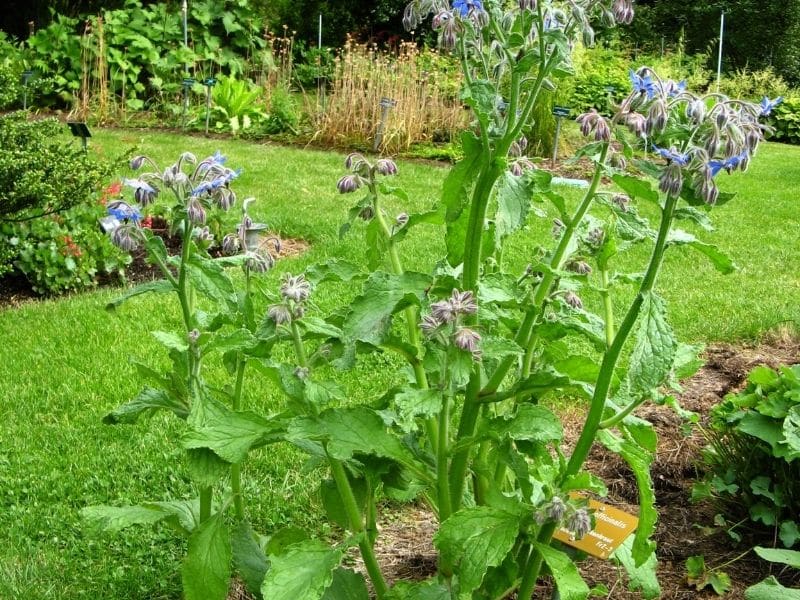Borage is an incredibly useful annual herb to grow in an organic garden. It can work well in mixed beds and borders, alongside perennials, and even in your kitchen vegetable garden. Borage is one of my favorite permaculture-friendly plants for those who wish to garden in a sustainable, wildlife-friendly, and organic way.

In this article, my goal is to help you understand how to grow this easy-care, low-maintenance plant, and why it is such a good idea to do so.
What is Borage?
Borage (Borago Officinalis) is a flowering annual herb, sometimes also referred to as starflower. It flowers from around June through to October in most temperate climates, growing up to around 2 ft tall at a medium rate. In warmer climate zones, it may even bloom almost continuously through a large proportion of the year.
This plant is native to the Mediterranean region. However, it has naturalized elsewhere and is a common sight in sustainable, organic, permaculture gardens across Europe and North America.
| Growing Zones | USDA Zones 3-10 |
| Plant Height | 18-30 inches |
| Plant Width | 24 inches |
| Soil pH Requirements | 4.5 to 8.5, Ideal pH is 6.5 |
| Light | Best in Full Sun |
| Annual | Self Seeding |
| Days To Germination | 7-14 Days |
Sowing and Growing Borage
Borage is usually grown from seed. The seeds are sown undercover in early spring and planted out once the weather warms, or direct sown in garden beds after the last frost date in the area.
Once sown, it can generally take care of itself. It should not require additional irrigation where rainfall is sufficient, just light irrigation or watering in arid areas. It does not usually need to be fed.
Your main tasks when it comes to growing borage will be determining where to grow them to take full advantage of their benefits and making full use of your plants (see below).
As a reliable self-seeder, borage can be sown just once. Providing it has been placed in the right spot; it should self-seed and pop up in your garden year after year.

Where to Grow Borage
Borage can be useful when grown:
- As a companion plant in vegetable beds or a kitchen garden.
- In a dedicated herb garden alongside perennial and annual herbs.
- As part of a fruit tree guild.
- In planting around fruit bushes, fruiting canes, or other perennial plants.
- In a low-maintenance ornamental bed or border alongside flowering perennials and other self-seeding annual flowers.
Last update on 2025-07-13 / Affiliate links / Images from Amazon Product Advertising API
Why Grow Borage in Your Garden?
Borage is such a wonderful plant to grow because:
- It is unfussy when it comes to growing conditions. (It can cope with most soil types, including those low in fertility, or extremely alkaline in pH. It can survive even in very free-draining conditions and is pretty drought tolerant, and can grow in full sun, or light/dappled shade.)
- It is a reliable self-seeder in many settings – meaning that it can be right at home alongside and between sustainable, climate-conscious perennial plantings.
- Borages roots help to break up and aerate compacted soil. (So it can be used as a cover crop before other plants are grown.)
- Borage is a great companion in the vegetable garden or around fruiting plants. It is a fantastic nectary plant, re-filling with nectar for bees and other pollinators far more quickly than many other flowers. Its blue flowers attract pollinators to your garden.

- Borage is also a trap crop for aphids, helping to keep these sap-suckers away from your main crops as a companion plant.
- And since borage attracts aphids, it also attracts beneficial insects which predate them, such as ladybugs and lacewings, for example. Growing borage will help you attract plenty of these beneficial insects to your garden.
- Borage also attracts other useful wildlife. When it goes to seed, for example, borage can provide food for and attract a range of seed-eating bird species – like finches.
- Borage may also repel or deter certain pest species. While scientific evidence is insufficient, some gardeners swear that having borage in beds deters pests like cabbage moths and tomato hornworms, for example.

- What is more, borage is also a useful dynamic accumulator. It is good at accumulating potassium and other essential plant nutrients in its plant tissues. This means that it can reduce nutrient leaching and help make sure nutrients are gathered and stored.
- As a dynamic accumulator, borage is useful for chopping and dropping and for use as a mulch around other plants. It can also be beneficial to add it to a composting system. And you can also use it to make a liquid plant feed which is especially beneficial for fruiting plants.
- The nutrients in borage can also be useful for domestic livestock. If you keep chickens, borage can be a beneficial component in a forage mix, for example. You can also throw borage into their run to give them a healthy treat.
- Last but not least, borage can also be good for us to eat. This is an edible plant and cannot just be grown alongside edibles but is also delicious in its own right. The leaves can be eaten in small quantities, raw or cooked. The flowers are also edible, raw as a garnish, in salads, or added to summer drinks. They have a cucumber-like flavor. The seeds also yield an oil that is high in gamma-linolenic acid. Borage is also a common ingredient in herbal medicine and has a range of health benefits.
Check Out These Recipes Using Borage
- BLUE ON BLUE! BLUE BLOSSOM SALAD: BLUE CHEESE, BORAGE & GRILLED CHICKEN SALAD RECIPE
- Creamy Borage Soup
- Borage Party Spread
(Just a couple of notes: people with liver problems should generally avoid eating borage, and due to small quantities of pyrrolizidine alkaloids, no one should make borage a major part of their diet.)
Of course, borage is also a very attractive plant, with its delicate blue flowers. It can also be an attractive ornamental addition to your garden. Since borage is such an easy plant to grow, there are no reasons not to grow borage in your permaculture garden, and, as you can see above, there are many reasons why you should.





I Love borage but will never again grow it with my tomatoes. The year that I did the borage was covered with caterpillars which moved to the tomato plants destroying most of the crop. I now plant it my itself in the bee yard.
Also I suggest wearing gloves when working around it because borage stems and leaves are covered with tiny hairs that very irritating. Trust me on that!